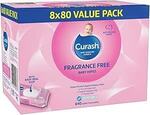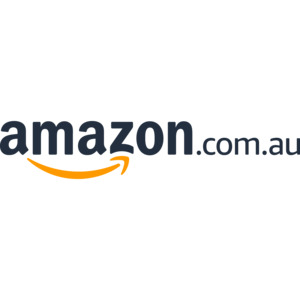Lower end of the pricing cycle - worth stocking up.
Curash Fragrance Free Baby Wipes, 8pk of 80 Wipes $18.31 ($16.48 S&S) + Delivery ($0 with Prime/ $59 Spend) @ Amazon AU
Last edited 30/04/2025 - 12:13 by 1 other user
 CamelCamelCamel.
CamelCamelCamel.Related Stores
closed Comments

brand matters
quality matters

oh yes, we experimented with a lot of Fragrance Free wipes thinking No Fragrance has no added irritants right?
Wrong - rashes still happened until we switched to Curash Fragrance Free

Similar priced perhaps but different product experience.

Aldi is cheaper
These are $2.86 per 100
Aldi is $2.39 per 100Aldis price is all the time, not "some of the time"

Not a attractive price.

It's worth noting that some studies have raised concerns about the toxicity of phenoxyethanol, an ingredient found in Curash wipes, including this.

I have read concerns about this from other Ozb threads, but to me this seems like something a non-issue that people just like to parrot in every thread.
I ran the query through the Deep Research function of ChatGPT to get a good source driven summary:
TL;DR: In summary, phenoxyethanol is widely used (typically <1%) as a preservative in baby wipes and is generally regarded as safe for infants and toddlers. Authoritative reviews and regulators find that at these low concentrations it is only weakly irritating and a very rare allergen. Special cases – broken or very immature skin, or ingestion – warrant caution, but for normal diaper-area wiping no systemic harm has been demonstrated. Leading safety panels (EU’s SCCS, the US FDA) and professional groups all treat phenoxyethanol as acceptable in baby products when used properly. Parents concerned about sensitivities can opt for phenoxyethanol‑free wipes or test a small patch first, but for most infants standard wipes with ≤1% phenoxyethanol pose no significant risk.
Phenoxyethanol in Baby Wipes: Safety and Regulatory Guidance
Baby wipe formulations typically contain water and mild surfactants, so preservatives like phenoxyethanol are added to prevent microbial growth. Phenoxyethanol is a common paraben-free preservative used in many cosmetics and wipes. Regulatory authorities have generally found it safe at low concentrations. For example, the European Cosmetic Regulation (Annex V of EC 1223/2009) permits phenoxyethanol up to 1.0% by weight in all products. The EU Scientific Committee on Consumer Safety (SCCS) reviewed the data and concluded that phenoxyethanol “is safe for all consumers – including children of all ages – when used … at a maximum concentration of 1%”. In practice, most wipes use ≤0.7% phenoxyethanol. (For perspective, Animal LD₅₀ values are on the order of 2–4 g/kg, far above any human exposure from wipes.) In contrast to older preservatives (formaldehyde donors, methylisothiazolinone) that were removed after dermatitis reports, phenoxyethanol is one of the milder options and is “neither a primary irritant or sensitizer” at these use levels. Major wipe manufacturers also report that their products contain phenoxyethanol at under 1% and have found no safety concerns at those levels. In fact, expert reviews note that properly-formulated baby wipes (with mild preservatives) can improve skin care: five clinical studies showed wipes were superior to water-and-cloth for diaper cleaning and helped maintain normal skin pH and barrier function.
Regulatory limits and guidance: In Europe phenoxyethanol is allowed up to 1.0% in cosmetics (all products). The SCCS opinion (2016) reaffirmed safety at this level even for children. However, French authorities have taken a precautionary stance for very young infants: a 2012 French (ANSM) risk assessment recommended lowering the limit to 0.4% in products for children under 3 and avoiding use on the nappy/diaper area. In 2019 ANSM required a warning label on leave-on products (including wipes) stating they should not be used on the diaper area of children ≤3 years. (This was a precautionary measure citing animal studies of reproductive/developmental effects at high doses, although no such effects have been reported in humans.) In the US, FDA does not pre-approve cosmetic preservatives and has not set a specific phenoxyethanol limit. The FDA’s main action was a 2008 safety alert: a nipple cream containing phenoxyethanol caused central nervous system depression (with vomiting/diarrhea) in breastfed infants, but that was an ingestion exposure (not wipe use). The FDA and EPA generally consider phenoxyethanol safe as used, and major manufacturers say their wipes comply with FDA, WHO and EU safety standards.
Pediatric and dermatology groups note that preservatives in wipes can cause allergies in sensitive babies. The American Academy of Pediatrics highlights that “fragrances or preservatives in diaper wipes or creams” are among common allergens in diaper-area rashes. Likewise, clinical dermatologists consider phenoxyethanol a rare sensitizer but acknowledge it can trigger contact eczema or hives in some individuals. Case reports (e.g. from Doppler ultrasound gel or skin care products) have linked phenoxyethanol to allergic contact dermatitis and even rare anaphylaxis. That said, these reactions are uncommon. Many safety reviews describe phenoxyethanol as “one of the most well-tolerated preservatives” used in cosmetics, with allergy prevalence low. Notably, eczema from phenoxyethanol typically appears only at the application site and resolves on avoidance. The US HealthyChildren.org (AAP) website advises parents to watch for rashes that recur with the same product – a clue to an allergic reaction – and notes that eliminating the offending preservative often clears the rash.
Skin irritation: Under normal use, phenoxyethanol is generally non-irritating. Regulatory testing found that at typical wipe concentrations it “is not a primary irritant” to skin or eyes. Occupational and cosmetic safety panels have similarly found only mild, reversible irritation in animal studies even with repeated exposure. (For example, guideline tests in rabbits showed only mild skin redness at high doses.) In practice, most babies tolerate it well. When irritation does occur, it is often hard to distinguish from diaper dermatitis caused by wetness or friction. To minimize any risk, clinicians recommend using gentle, fragrance- and alcohol-free wipes and avoiding harsh rubbing. If a baby develops persistent redness or rash in the diaper area, switching to a different product (or plain water) for a trial period is advised.
Systemic absorption and toxicity: Phenoxyethanol is absorbed through skin at moderate rates. In one human skin model, roughly 40–47% of a 1% solution was absorbed from a rinse-off preparation, and about 78–85% was absorbed from a leave-on preparation. (Baby wipes are leave-on by nature, so a high fraction of the preservative can penetrate the skin surface.) However, the absolute amount per wipe is small (e.g. 0.7% of a few milliliters) and systemic exposure is very low. Comprehensive reviews emphasize that only extremely high doses cause harm: in animals adverse systemic effects occurred at ∼200 times the exposure expected from consumer use. No reproductive or chronic toxicity has been documented in humans at cosmetic exposure levels. Consistent with this, phenoxyethanol is not classified as a developmental or reproductive toxin under current EU/GHS rules, and the SCCS identified no safety concerns at 1%. The one clear systemic hazard was seen in the FDA infant alert (ingestion of nipple cream), which involved much larger exposure than wiping. In short, toxicologists consider typical wipe use highly unlikely to cause systemic effects. Nevertheless, extra caution is suggested for very young or fragile infants: premature newborns have a more permeable skin barrier and can absorb more of a topical agent, so some experts advise supervised or minimal-use cleaning in these cases.
Clinical data: Several controlled studies in infants have confirmed that modern wipes (with appropriate preservatives) are safe and effective. For instance, trials have found no increase in diaper-area erythema or barrier dysfunction from using wipes versus water. One dermatological review concludes that phenoxyethanol “can be considered one of the most well-tolerated preservatives” used in cosmetic products. Likewise, clinical evaluations of baby skincare products generally report excellent tolerability of phenoxyethanol at low concentrations. No large-scale adverse-event reports have emerged from pediatric use of wipes, and serious allergic reactions are exceedingly rare.
Guidelines and Concentration Limits: Regulatory and expert guidance emphasize using phenoxyethanol only at recommended levels. As noted, the EU ceiling is 1%. France recommends 0.4% for children’s products and advises labeling to avoid diaper-area use. No comparable binding limits exist in the US (apart from general cosmetic safety requirements), but US manufacturers voluntarily formulate wipes with low preservative levels and often highlight compliance with international safety panels. Parents can check product labels: phenoxyethanol will be listed among ingredients (sometimes as “2-phenoxyethanol”). Given the potential for preservative allergy, both pediatricians and dermatologists suggest choosing fragrance-free, mild wipes and watching for any skin reaction. When in doubt, consulting a pediatrician or allergist is prudent if a rash persists.
Summary: In summary, phenoxyethanol is widely used (typically <1%) as a preservative in baby wipes and is generally regarded as safe for infants and toddlers. Authoritative reviews and regulators find that at these low concentrations it is only weakly irritating and a very rare allergen. Special cases – broken or very immature skin, or ingestion – warrant caution, but for normal diaper-area wiping no systemic harm has been demonstrated. Leading safety panels (EU’s SCCS, the US FDA) and professional groups all treat phenoxyethanol as acceptable in baby products when used properly. Parents concerned about sensitivities can opt for phenoxyethanol‑free wipes or test a small patch first, but for most infants standard wipes with ≤1% phenoxyethanol pose no significant risk.
Sources: Expert reviews and clinical studies, regulatory statements (EU Cosmetics Reg. Annex V, FDA alerts, ANSM guidance), and pediatric dermatology guidelines were used to compile this assessment.

Wipes bad vaccines bad let's get measles

Alright. When deciding between 'no significant risk' and an option without these ingredients (e.g., Huggies - even cheaper now https://amzn.asia/d/2KdHndG) , the choice is yours. However, it's always best to ensure people make an informed decision.

Curash Water wipes also available for the same price.
Could only find 6 x 80 @ $16.32?

Ah you are right, sorry about that. Didn't notice it was only a 6pk.

Aldi ones are much thicker and larger. Bought 2 boxes of these 8 packs during the last Amazon sale. I have to use 2 pieces of these to clean my hands vs 1 piece of the aldi one. I’ve also tried boxes of the Huggies brand but they are similar to the curash ones (smaller size and thinner) compared to Aldi

Can you please advise what's the brand name for the Aldi one?

Mamia.

Thanks!

Mamamia

Thanks!

Is it bad if I S&S for a month and cancel after that?

I cancel my s&s as soon as I’ve placed an order. Nothing bad about it - you cancel whenever you feel obliged!

No

This the way. The only way

Cancel right away to avoid surprised paying full price.

You don't even have to give a reason for why you're cancelling the subscription anymore.

Bad for who? Billionaire Bezos?
I doubt the computer that processes your cancellation cares :-)

I usually wait until I've received the product before cancelling, but I don't think it matters. If you're concerned, just make it a 6 month subscription and you'll get an email a few weeks before reorder if you forget to cancel anyway

are these good for cleaning up intense cardiovascular activities in the bedroom? asking for a friend.

Big fan of the blue curash over the pink. Subjective but to me the scented are better.

Seems not a very good bargain.





That's pretty much the same as the standard price at Aldi (different brand) if I am not mistaken?!